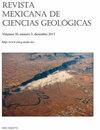Identification of jarosite and other major mineral Fe phases in acidic environments affected by mining-metallurgy using X-ray Absorption Spectroscopy: With special emphasis on the August 2014 Cananea acid spill
IF 0.5
4区 地球科学
Q4 GEOSCIENCES, MULTIDISCIPLINARY
Revista Mexicana De Ciencias Geologicas
Pub Date : 2019-07-28
DOI:10.22201/CGEO.20072902E.2019.2.1021
引用次数: 3
Abstract
The sulfuric acid spill into the Sonora river, enriched in iron and copper ions from the Buenavista del Cobre mine (Cananea), gave way to the formation of various solid iron (Fe) phases. In this study, the mineral phases were identified by X-ray Absorption Spectroscopy (XAS) and bulk powder X-Ray Diffraction (XRD), and chemically through acid digestions for multielemental quantification, as well as a 3-step selective sequential extraction (SSE) to quantify the types of Fe oxide phases and the contribution of the associated elements. Jarosite was the only Fe mineral identified by XRD, but XAS allowed identification of jarosite with potentially toxic elements (PTEs) incorporated in its structure, making these elements less prone to leaching. In addition, very poorly crystalline phases such as schwertmannite and ferrihydrite were identified in several samples through XAS, which was confirmed by SSE. These phases are probably associated with PTEs. Other possible adsorbent Fe(III) minerals were also identified by XAS, such as maghemite and goethite; as well as mixed Fe(II)-Fe(III) minerals, such as green rust. It was possible to infer the influence of the acid spill on the different sampled areas through various Fe phases identified and/or the presence of gypsum. The influence was detected to be lower where the mineralogy was not associated to low pH and high sulfate concentrations. All precipitated Fe(III) phases downriver from the acid spill are known for their high retention capacities of PTEs either from incorporation into their structures and/or from surface adsorption, thus, contributing to the immobilization of the initial metal(loid) pollution caused by the acid spill. In addition, several other samples of mining-metallurgical wastes were analyzed by the same three techniques, suggesting many of the findings from the secondary Fe mineralogy of the Buenavista del Cobre mine acid spill as common processes occurring in mining-affected environments.使用X射线吸收光谱法识别受采矿冶金影响的酸性环境中的黄钾铁矾和其他主要矿物Fe相:特别强调2014年8月卡纳酸泄漏
从Buenavista del Cobre矿(Cananea)泄漏到索诺拉河的硫酸富含铁和铜离子,让位于各种固体铁(Fe)相的形成。本研究通过x射线吸收光谱(XAS)和体粉x射线衍射(XRD)对矿物相进行鉴定,并通过酸消化法进行多元素定量,通过3步选择性顺序萃取法(SSE)定量铁氧化物相的类型和伴生元素的贡献。黄钾铁矾是唯一通过XRD鉴定出的铁矿物,但XAS可以鉴定出含有潜在有毒元素(pte)的黄钾铁矾,使这些元素不容易浸出。此外,在多个样品中通过XAS鉴定出了schwertmannite和ferrihydrite等非常差的晶相,SSE证实了这一点。这些相位可能与pte有关。XAS还发现了其他可能的吸附铁(III)矿物,如磁铁矿和针铁矿;以及混合铁(II)-铁(III)矿物,如绿锈。可以通过确定的不同铁相和/或石膏的存在来推断酸溢出对不同采样区域的影响。在矿物学与低pH值和高硫酸盐浓度无关的地方,检测到的影响较低。所有从酸泄漏下游析出的Fe(III)相都以其pte的高截留能力而闻名,这些截留能力来自于pte的结构和/或表面吸附,因此有助于固定酸泄漏引起的初始金属(样蛋白)污染。此外,用同样的三种技术分析了采矿-冶金废物的其他几个样品,表明从Buenavista del Cobre矿酸泄漏的次级铁矿物学中发现的许多结果是在受采矿影响的环境中发生的常见过程。
本文章由计算机程序翻译,如有差异,请以英文原文为准。
求助全文
约1分钟内获得全文
求助全文
来源期刊

Revista Mexicana De Ciencias Geologicas
地学-地球科学综合
CiteScore
1.00
自引率
12.50%
发文量
0
审稿时长
6-12 weeks
期刊介绍:
Revista Mexicana de Ciencias Geológicas (RMCG) publishes original research papers on geological processes of broad interest, and particularly those dealing with regions of Latin America. The RMCG also publishes review papers on topics of current interest, and on the geology and tectonics of geological provinces of Latin America. Besides, it offers the opportunity for host editors to publish special thematic issues.
 求助内容:
求助内容: 应助结果提醒方式:
应助结果提醒方式:


